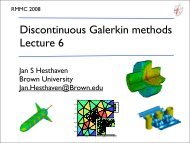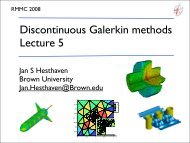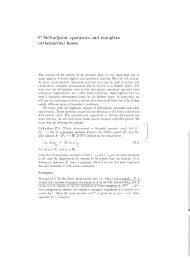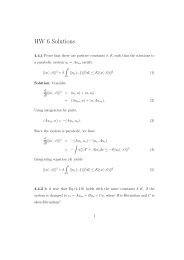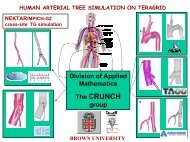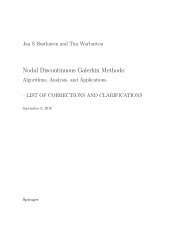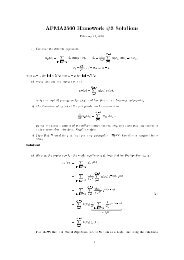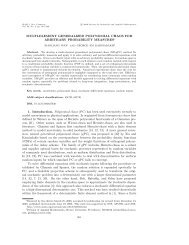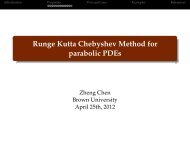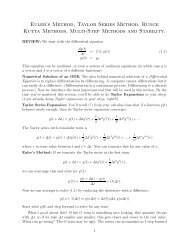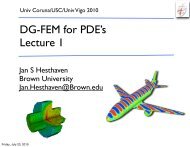Discontinuous Galerkin methods Lecture 1 - Brown University
Discontinuous Galerkin methods Lecture 1 - Brown University
Discontinuous Galerkin methods Lecture 1 - Brown University
Create successful ePaper yourself
Turn your PDF publications into a flip-book with our unique Google optimized e-Paper software.
sic understanding of the schemes through a simple example.<br />
The first DG schemes<br />
firstx schemes ∈ D k : u k k x − xk+1<br />
h(x) =u<br />
xk x − xk<br />
+ uk+1<br />
− xk+1 xk+1 1<br />
= u<br />
− xk k+i ℓ k i (x) ∈ Vh,<br />
So let us consider the scalar problem<br />
e linear scalar wave equation<br />
ise for the flux, f<br />
∂u ∂f(u)<br />
+ =0, x ∈ [L, R] =Ω,<br />
∂t ∂x<br />
near flux is given as f(u) =au. This is subject to the appropriate initial condit<br />
We form the local residual<br />
u(x, 0) = u0(x).<br />
onditions are given when the boundary is an inflow boundary, that is<br />
k h . The space of basis functions is defined as Vh = ⊕K <br />
k<br />
k=1 ℓi of piecewise polynomial functions. Note in particular that there is no restric<br />
ss of the test functions between elements.<br />
the finite element case, we now assume that the local solution can be well re<br />
pproximation uh ∈ Vh and form the local residual<br />
x ∈ D k : Rh(x, t) = ∂uk h<br />
∂t + ∂f k h − g(x, t),<br />
∂x<br />
u(L, t) =g(t) if a ≥ 0,<br />
u(R, t) =g(t) if a ≤ 0.<br />
ate Ω by K nonoverlapping elements, x ∈ [xk l ,xkr]=D k lement. Going back to the finite element scheme, we recall that the global c<br />
and require this to vanish locally in a <strong>Galerkin</strong> sense<br />
ual are the source of the global nature of the operators M and S in Eq. (1.4).<br />
equire that the residual is orthogonal to all test functions φh ∈ Vh, leading t<br />
D , as illustrated in Fig.<br />
e elements we express the local solution as a polynomial of order N<br />
k<br />
Rh(x, t)ℓ k j (x) dx =0,<br />
x ∈ D k : u k Np <br />
h(x, t) = û k Np <br />
n(t)ψn(x) = u k h(x k i ,t)ℓ k and the fact that we have duplicated solutions at all interface nodes.<br />
is locality also appears problematic as this statement does not<br />
i (x). allow one to recov<br />
obal solution. Furthermore, the points at the ends of the elements are shared by<br />
n=1<br />
i=1<br />
i=0<br />
1 Introduction<br />
The problem is that all elements are now disconnected<br />
due to the local statement on the residual!<br />
t functions, ℓ k j (x). The strictly local statement is a direct consequence of Vh bein



